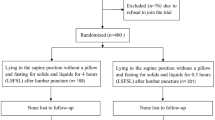Abstract
Purpose
Lumbar puncture (LP) is one of the most common procedures performed in medicine. The aim of this prospective study is to determine the success rate of LP in lateral decubitus with 45-degree head-up tilt position, and compare it with traditional positions like sitting and lateral decubitus.
Methods
Three hundred and thirty patients between 25 and 85 years of age who had undergone abdominal, urologic, and lower limb extremities surgeries were enrolled and 300 patients were divided into three different groups. The LP was performed with a 25-G atraumatic needle, either in the standard sitting position (group S, n = 100), lateral decubitus, knee-chest position (group L, n = 100) or lateral decubitus, knee-chest position with a 45-degree head-up tilt (group M, n = 100). The free flow of clear cerebrospinal fluid (CSF) upon first attempt was considered to be evidence of a successful LP.
Results
Total LP success rate was significantly higher in group M (85 %) than in groups S and L (70 and 65 %, respectively) (p = 0.004). When the significance between the groups was evaluated according to age, the increase in the LP success rate was not significant for ≤65 and >65 age groups. There were no differences among the three groups in terms of bloody CSF (p = 0.229) and the number of attempts before dural puncture (p = 0.052).
Conclusions
The lateral decubitus in knee-chest position with a 45-degree head-up tilt may be the preferred position for spinal anesthesia in young and elderly patients, due to the high success rate.

Similar content being viewed by others
References
Apiliogullari S, Duman A, Gok F, Ogun CO, Akillioglu I. The effects of 45 degree head up tilt on the lumbar puncture success rate in children undergoing spinal anesthesia. Paediatr Anaesth. 2008;18:1178–82.
Fisher A, Lupu L, Gurevitz B, Brill S, Margolin E, Hertzanu Y. Hip flexion and lumbar puncture: a radiological study. Anaesthesia. 2001;56:262–6.
Boon JM, Abrahams PH, Meiring JH, Welch T. Lumbar puncture: anatomical review of a clinical skill. Clin Anat. 2004;17:544–53.
Sandoval M, Shestak W, Stürmann K, Hsu C. Optimal patient position for lumbar puncture, measured by ultrasonography. Emerg Radiol. 2004;10:179–81.
Baigmohammadi MT, Khan ZH. Modified sitting position: a new position for spinal anesthesia. Anesth Analg. 2007;105:549.
Sprung J, Bourke DL, Grass J, Hammel J, Mascha E, Thomas P, Tubin I. Predicting the difficult neuraxial block: a prospective study. Anesth Analg. 1999;89:384–9.
Ferre RM, Sweeney TW, Strout TD. Ultrasound identification of landmarks preceding lumbar puncture: a pilot study. Emerg Med J. 2009;26:276–7.
Bogduk N, Twomey LT. Clinical anatomy of the lumbar spine. 2nd ed. Edinburgh: Churchill Livingstone; 1991. p. 69.
Kopacz DJ, Neal JM, Pollock JE. The regional anesthesia “learning curve”: what is the minimum number of epidural and spinal blocks to reach consistency? Reg Anesth. 1996;21:182–90.
Boon JM, Prinsloo E, Raath RP. A paramedian approach for epidural block: an anatomic and radiologic description. Reg Anesth Pain Med. 2003;28:221–7.
Ellis H, Feldman S. Anatomy for anesthetists. 7th ed. Oxford: Blackwell Science; 1997. p. 108–12.
Marton KI, Gean AD. The spinal tap: a new look at an old test. Ann Intern Med. 1986;104:840–8.
Eskey CJ, Ogilvy CS. Fluoroscopy guided lumbar puncture: decreased frequency of traumatic tap and implications for the assessment of CT-negative acute subarachnoid hemorrhage. Am J Neuroradiol. 2001;22:571–6.
Acknowledgments
Support was provided from institutional and/or departmental sources.
Conflicts of interest
None of the authors has any conflicts of interest or competing interests in the research performed in this study.
Author information
Authors and Affiliations
Corresponding author
About this article
Cite this article
Sahin, S.H., Colak, A., Arar, C. et al. Modified 45-degree head-up tilt increases success rate of lumbar puncture in patients undergoing spinal anesthesia. J Anesth 28, 544–548 (2014). https://doi.org/10.1007/s00540-013-1764-8
Received:
Accepted:
Published:
Issue Date:
DOI: https://doi.org/10.1007/s00540-013-1764-8




